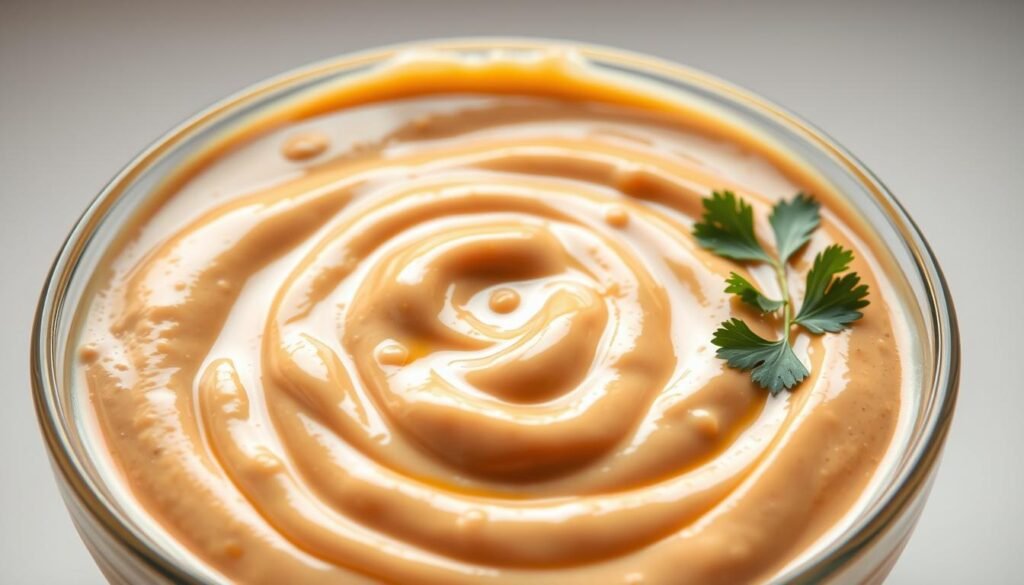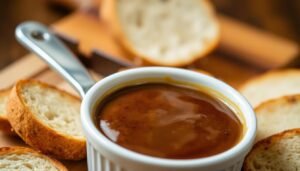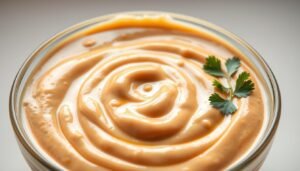I still remember my first taste of peanut sauce. It was at a Thai restaurant, and it changed how I see this condiment. Did you know peanut sauce is not just tasty? It’s also versatile, making dishes like noodles and grilled meats better.
Making creamy peanut sauce at home is easy. With a few ingredients, you can whip up a delicious sauce. It’s great with your favorite dishes, including a hearty crockpot chili.
In this article, I’ll show you how to make a simple peanut sauce recipe. You can adjust it to your liking. Whether you love trying new flavors or just want to try something different, this guide is for you.
Key Takeaways
- Learn how to make a simple creamy peanut sauce at home.
- Discover the health benefits of peanut sauce.
- Explore various ways to use peanut sauce in your cooking.
- Find out how to customize the peanut sauce recipe to suit your taste.
- Get tips on pairing peanut sauce with other dishes.
Introduction to Peanut Sauce
Peanut sauce is more than a tasty addition to meals. It shows the cultural heritage of the regions where it’s loved. As someone who loves global cuisine, I find peanut sauce fascinating.
Let’s explore peanut sauce together. We’ll learn what it is and where it comes from. This journey will make you appreciate this condiment more and inspire you to use it in your cooking.
What is Peanut Sauce?
Peanut sauce is a creamy condiment made from peanuts. It’s used in Southeast Asian and African cooking. You can use it as a dip, marinade, or sauce for many dishes. It’s made with peanuts or peanut butter, water or coconut milk, and seasonings like soy sauce, garlic, and ginger.
Key Ingredients: Peanuts or peanut butter, coconut milk, soy sauce, garlic, ginger, and sometimes sweeteners like honey or sugar.
Origins and Cultural Significance
Peanut sauce comes from Southeast Asian cuisine, mainly from Indonesia and Thailand. In Indonesia, it’s key for satay, grilled meat skewers. Thai cuisine also uses peanut sauce a lot, in noodle recipes and as a dipping sauce. Peanut sauce is more than taste; it’s a part of the culinary identity of these regions.
In Thai cuisine, peanut sauce is a big part of dining. It’s served with satay or used in noodle dishes. You can try peanut sauce with meals like Crockpot Chili for a unique taste.
| Culture | Usage of Peanut Sauce | Common Dishes |
|---|---|---|
| Indonesian | Essential for satay | Satay, Gado-Gado |
| Thai | Used in noodle dishes and as a dip | Pad Thai, Satay |
| African | Used in stews and as a condiment | Groundnut Stew |
Knowing where peanut sauce comes from and its cultural importance can make your cooking better. It lets you enjoy the flavors and traditions behind this beloved condiment.
Ingredients for Your Peanut Sauce
A great peanut sauce starts with the right ingredients. You can make a classic or try something new. Knowing what each ingredient does is important.
Essential Ingredients
To make a basic peanut sauce, you need a few key things. Peanuts or peanut butter are the base, giving it a rich, nutty taste. Garlic and ginger add depth and warmth. Soy sauce brings a salty, umami flavor. Adding a sweetener like honey or sugar helps balance the taste.
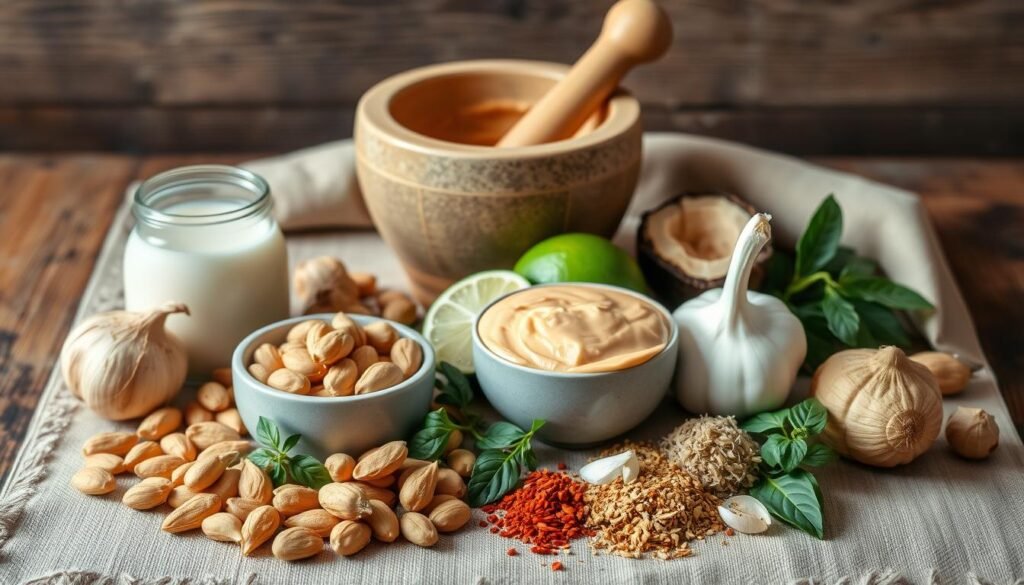
| Ingredient | Role in Peanut Sauce |
|---|---|
| Peanuts/Peanut Butter | Base ingredient for nutty flavor |
| Garlic | Adds depth and warmth |
| Ginger | Contributes to the aromatic flavor |
| Soy Sauce | Provides salty, umami taste |
| Honey/Sugar | Balances out the flavors with sweetness |
Optional Add-Ins for Extra Flavor
You can also add extra ingredients to your peanut sauce. Try chili flakes or hot sauce for spice. Or, add lime juice for a tangy taste. For a richer flavor, use coconut milk. For freshness, add herbs like cilantro or basil.
For a tasty dish, try this Slow Cooker Pulled Chicken recipe. It uses a 5-ingredient peanut sauce that’s sure to wow.
The Health Benefits of Peanut Sauce
Peanut sauce is packed with nutrients, making your meals tastier and healthier. It adds protein, healthy fats, and fiber. This makes it a better choice than many other sauces.
Nutritional Overview
Peanut sauce comes from peanuts, which are good for your heart. They have monounsaturated and polyunsaturated fats that lower bad cholesterol. Peanuts also have protein and fiber, boosting your diet’s health.
Adding garlic and ginger to peanut sauce can make it even better. Garlic has antioxidants, and ginger helps with digestion.
| Nutrient | Amount per Serving | % Daily Value |
|---|---|---|
| Protein | 8g | 16% |
| Fat | 16g | 25% |
| Fiber | 2g | 8% |
Why Choose Natural Peanuts?
Going for natural peanuts over processed ones is healthier. Natural peanuts have fewer preservatives and less salt.
“Using natural ingredients not only enhances the flavor but also ensures that you’re getting the most nutritional benefits from your peanut sauce.”
Choosing natural peanuts and minimal processing keeps your sauce nutritious. It lets you control salt and sugar levels too.
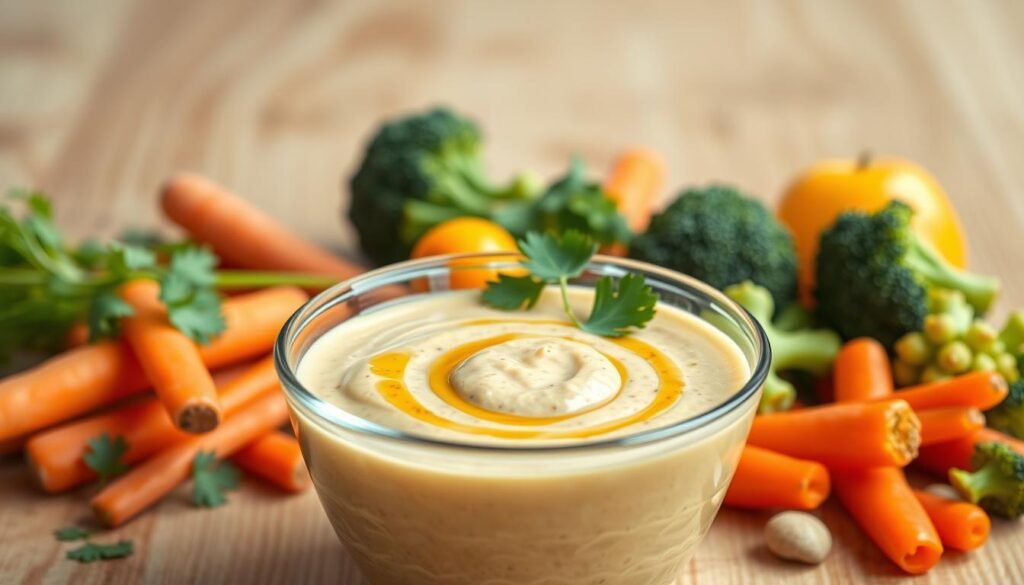
Knowing the health perks of peanut sauce and picking natural ingredients makes it a great choice. It’s perfect as a dip, sauce, or in crockpot chili. Peanut sauce is both tasty and healthy.
Step-by-Step Instructions for Peanut Sauce
Making peanut sauce from scratch is easy. You need just a few ingredients and basic tools. The secret to a great sauce is in how you mix and blend the ingredients.
Preparing Your Ingredients
First, prepare your ingredients. Measure out the peanuts, garlic, ginger, and more. For a basic sauce, you’ll need peanuts or peanut butter, coconut milk, soy sauce, honey, garlic, and ginger. If using whole peanuts, roast them until lightly browned to enhance flavor.
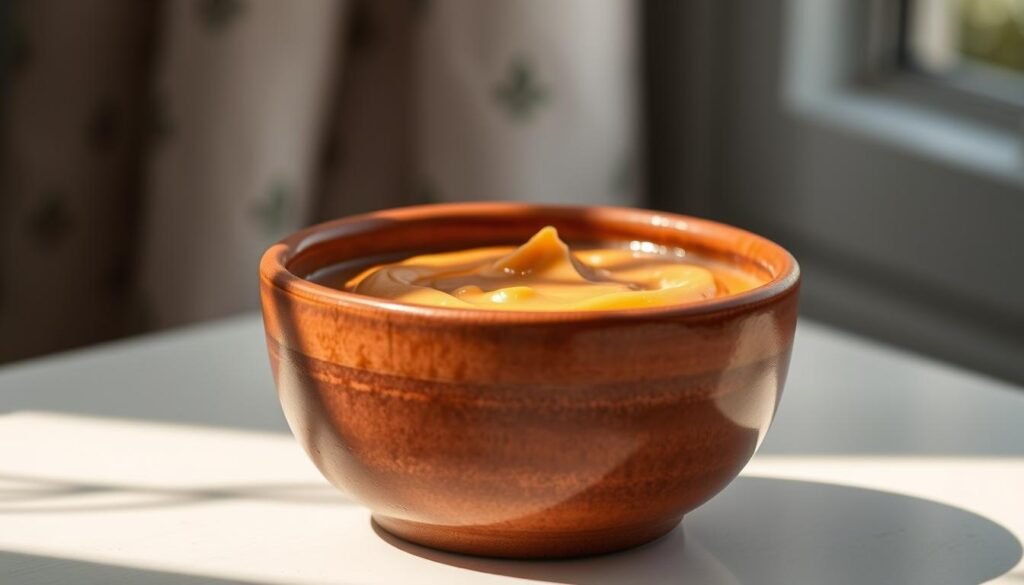
Mixing and Blending Techniques
Now, blend your ingredients. In a blender or food processor, mix peanuts or peanut butter, coconut milk, soy sauce, honey, garlic, and ginger. Blend on high until smooth and creamy. You might need to stop and scrape the sides a few times.
For a creamier sauce, add more coconut milk or a little water. Aim for a pourable but thick consistency.
Adjusting for Desired Consistency
The sauce’s consistency depends on its use. A thicker sauce is good for dipping, while a thinner one is better for salads or noodles. To thicken, simmer on low heat, stirring constantly, until it’s right.
Here’s a simple table to help adjust the consistency:
| Desired Consistency | Adjustment Method |
|---|---|
| Thicker | Simmer on low heat, stirring constantly |
| Thinner | Add a bit more coconut milk or water |
By following these steps and adjusting the consistency, you can make a peanut sauce perfect for your dishes.
Variations of Peanut Sauce
Peanut sauce is a blank canvas for your creativity. You can make it spicy, sweet, or tangy. It’s a versatile condiment for many dishes.
Spicy Peanut Sauce Recipe
For a spicy kick, try a spicy peanut sauce. Add chili peppers or red pepper flakes to your basic recipe.
To make spicy peanut sauce, blend peanut butter with soy sauce, lime juice, honey, garlic, and ginger. Add chili peppers or flakes to your taste.
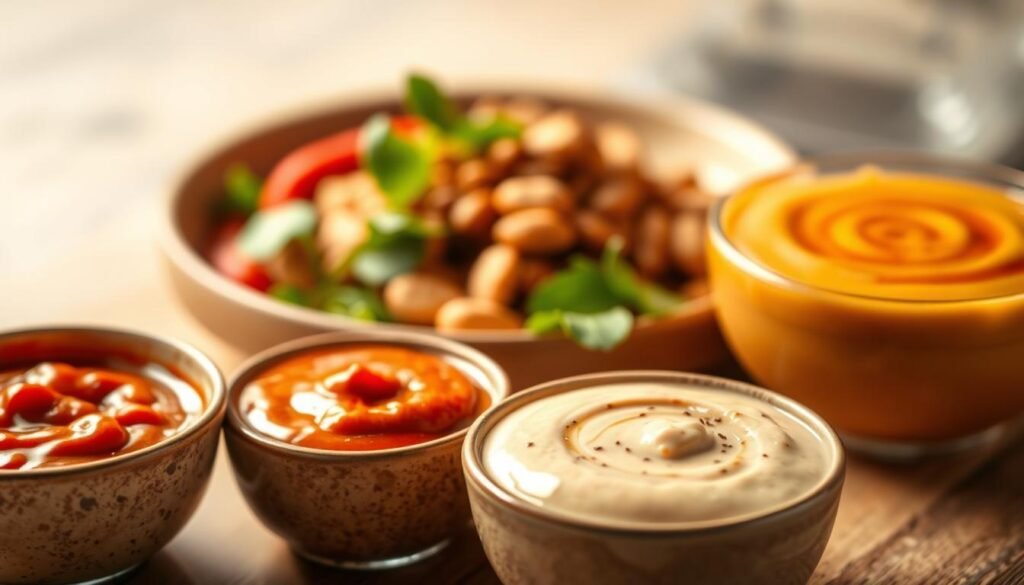
Sweet and Tangy Peanut Sauce
A sweet and tangy peanut sauce is great with grilled meats or as a dip. Add more honey or maple syrup for sweetness. Use extra lime juice for tanginess.
For a sweet and tangy sauce, blend peanut butter with soy sauce, honey, lime juice, and a bit of garlic. It’s perfect for those who like milder flavors.
| Peanut Sauce Variation | Key Ingredients | Best Used With |
|---|---|---|
| Spicy Peanut Sauce | Chili peppers, red pepper flakes | Noodles, stir-fries |
| Sweet and Tangy Peanut Sauce | Honey, lime juice | Grilled chicken, vegetables |
For more ideas on using peanut sauce, check out this creative peanut butter recipe. It uses peanut butter in a unique way.
Pairing Ideas for Peanut Sauce
Peanut sauce is great with many foods. It can make your meals better or become a new favorite snack.
Great Dishes to Serve with Peanut Sauce
Peanut sauce is key in Southeast Asian cooking. It goes well with:
- Satay: Grilled meat skewers, like chicken, beef, or pork, get a rich flavor boost from peanut sauce.
- Noodle dishes: It adds a creamy, nutty taste to pad thai or noodle salads.
- Stir-fries: Peanut sauce can make stir-fries taste better and is great over rice.
Try peanut sauce with Crockpot Chili for a mix of flavors.
Snacks That Pair Well
Peanut sauce is also good with snacks. Here are some favorites:
| Snack | Description |
|---|---|
| Vegetable sticks | Carrot, celery, and cucumber sticks are crunchy with peanut sauce. |
| Spring rolls | Fried or fresh, spring rolls pair well with peanut sauce. |
| Crackers | Crackers and peanut sauce make for a quick, tasty snack. |
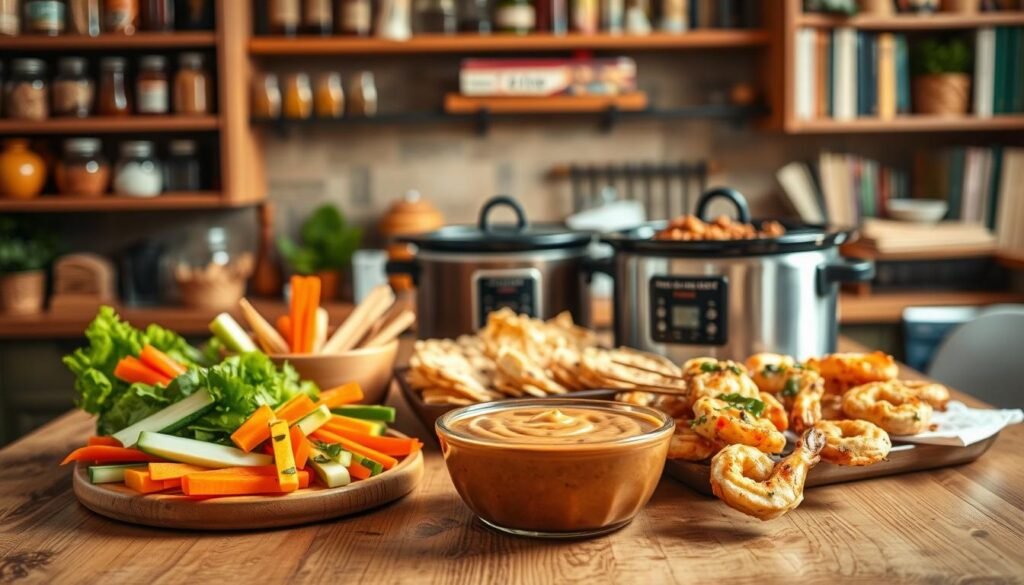
Try different pairings to find new favorites. Be creative and see what works best for you.
Storing Peanut Sauce
Keeping your homemade peanut sauce fresh and flavorful is crucial. Knowing how to store it right is key, whether you’re using it now or later.
Best Practices for Refrigeration
For storing peanut sauce in the fridge, follow some important tips. Always use an airtight container to keep it fresh. Glass jars with tight lids work best.
Let the sauce cool down before refrigerating. This step prevents condensation and mold. Your sauce can stay fresh for up to a week in the fridge.
How to Freeze Peanut Sauce
Freezing is a great way to keep peanut sauce longer. Pour it into an airtight container or freezer-safe bag. Leave some space for expansion.
Freezing in portions helps avoid waste. When you need it, thaw the sauce in the fridge or at room temperature. For quicker thawing, use cold water.
After thawing, stir the sauce well. Freezing can cause it to separate. By following these tips, your peanut sauce stays delicious for longer.
Troubleshooting Common Peanut Sauce Issues
Getting the perfect consistency for your peanut sauce is easier than you might think. Sometimes, it can be too thick or too thin. But don’t worry, there are easy fixes for these problems.
Sauce Too Thick? Solutions
If your peanut sauce is too thick, you can fix it. Add a bit of liquid like water, coconut milk, or soy sauce. Start with a teaspoon and add more until it’s right.
Another trick is to warm the sauce gently. Sometimes, it thickens when it cools. Warming it up can make it smooth again. But be careful not to heat it too much, or it might lose its flavor.
Sauce Too Thin? Tips to Thicken
If your sauce is too thin, there are ways to thicken it. One method is to simmer it for a few minutes. This lets some liquid evaporate, making the sauce thicker. Just watch it so it doesn’t get too thick.
You can also add peanut butter or ground peanuts to thicken it. Or, mix a little cornstarch or flour with water to make a slurry. Stir it into the sauce and cook for a couple of minutes to thicken.
| Issue | Solution | Tips |
|---|---|---|
| Sauce Too Thick | Add liquid (water, coconut milk, soy sauce) | Start with a small amount and adjust gradually |
| Sauce Too Thin | Simmer to reduce liquid or add thickening agents | Monitor consistency to avoid over-thickening |
“The key to a great peanut sauce is achieving the right balance of flavors and consistency. With a few simple adjustments, you can tailor it to your taste.”
Knowing how to fix common peanut sauce problems lets you adjust it perfectly. Whether it’s for a dip, dressing, or marinade, the right consistency is just a few tweaks away.
Creative Uses for Peanut Sauce
Peanut sauce is a versatile condiment that can elevate a variety of dishes. Its rich, nutty flavor makes it a perfect addition to many recipes, from savory meals to tasty snacks.
One of the most exciting aspects of peanut sauce is its ability to be used in various creative ways. As we’ll explore in this section, peanut sauce can be a great base for salad dressings and dips, adding a depth of flavor that’s hard to match with other ingredients.
Salad Dressings and Dips
Using peanut sauce as a salad dressing is a great way to add some excitement to your greens. Simply thin out the sauce with a bit of water or soy sauce to achieve your desired consistency. You can also add some lime juice or vinegar to give it a tangy twist.
As a dip, peanut sauce pairs well with vegetables, crackers, or even meat skewers. It’s a versatile dip that can be served at parties or used as a quick snack.
Marinades for Meat and Vegetables
Peanut sauce makes an excellent marinade for both meat and vegetables. The healthy fats and proteins in peanuts help to tenderize meat, while the flavor infuses deeply into the food.
For a simple marinade, mix peanut sauce with some soy sauce, garlic, and ginger. Let your choice of protein or vegetables soak in the mixture for at least 30 minutes before grilling or baking.
As noted by culinary experts, “The key to a great marinade is balance – you want a mix of flavors that complement the natural taste of the ingredients without overpowering them.” Using peanut sauce as a base, you can create a balanced and delicious marinade that elevates your dishes.
“Peanut sauce is not just a condiment; it’s a culinary canvas waiting for your creativity.”
Experimenting with peanut sauce in your kitchen can lead to some amazing discoveries. Whether you’re dressing a salad, dipping your favorite snack, or marinating meat for a barbecue, peanut sauce is sure to become a staple in your culinary repertoire.
Frequently Asked Questions about Peanut Sauce
Exploring peanut sauce can raise some questions. We’ll cover common ones about making and storing it. This will help you enjoy this tasty condiment even more.
How long does homemade peanut sauce last?
Homemade peanut sauce stays good for up to a week in the fridge. Make sure it’s in a tight container to keep it fresh. If it smells bad or has mold, throw it away.
Can I make peanut sauce without peanut butter?
You can make peanut sauce without peanut butter. Use raw peanuts instead. Blend them with garlic, ginger, and soy sauce for a similar taste. But, it might not taste exactly the same as the traditional version.
These FAQs should clear up any doubts about peanut sauce. Whether you’re experienced or new, knowing the basics can improve your cooking.
Conclusion: Enjoying Your Creamy Peanut Sauce
Now that you know how to make creamy peanut sauce, it’s time to have fun. This sauce can make many dishes better, from savory stir-fries to sweet desserts.
Exploring New Flavors
Start experimenting with peanut sauce to find new flavors. Add different ingredients to match your taste. You can make it spicy, tangy, or sweet. The choices are endless.
Sharing Your Creations
Share your peanut sauce dishes with friends and family, or online. It’s a great way to show off your cooking skills. You’ll also inspire others to try peanut sauce. Keep trying new things and you’ll find more recipes you love.

